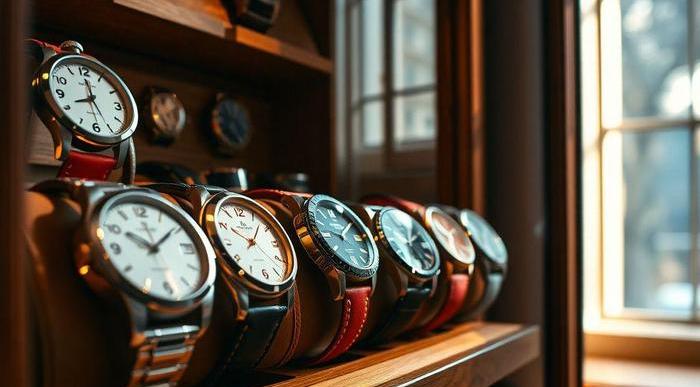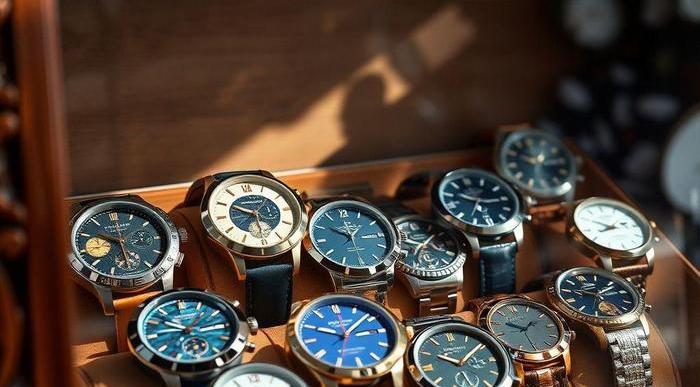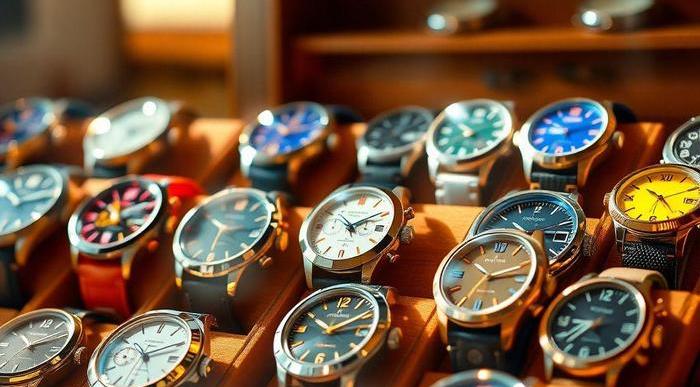A History Of Watches: From Sundials To Smartwatches
Note: This page contains affiliate links.
As an Amazon Associate, I earn from qualifying purchases when you click on the link, but you are not charged extra.
The evolution of timekeeping is a fascinating journey that reflects humanity’s quest for precision and organization. From the sun’s shadows cast upon ancient sundials to the sleek interfaces of modern smartwatches, the story of watches is intertwined with technological advancements, cultural shifts, and the very fabric of daily life. This exploration will traverse the timeline of horology, showcasing the ingenious developments that have marked each era.
The Evolution Of Timekeeping Devices
The history of timekeeping is as old as civilization itself, beginning with natural phenomena that humanity observed and recorded. Early humans relied on the sun, moon, and stars, using their predictable movements as guides to the passage of time. As societies grew more complex, the need for more precise timekeeping devices became paramount. This need spurred innovation, leading to a variety of mechanisms designed to measure time with increasing accuracy.
From Sundials To Hourglasses: Early Methods
Sundials, one of the earliest timekeeping devices, harnessed the sun’s position to indicate time. The concept is simple yet ingenious: a gnomon, or stick, casts a shadow on a flat surface marked with hours. Although effective, sundials are dependent on sunlight, making them impractical at night or during cloudy weather.
The invention of the hourglass, or sand timer, around the 8th century CE represented a significant advancement. Consisting of two glass bulbs connected by a narrow neck, the hourglass measures time by the flow of sand from one bulb to the other. Unlike sundials, hourglasses were portable and could be used in a variety of conditions, making them ideal for maritime navigation and other critical applications.
Other ancient civilizations contributed to timekeeping innovations. The Egyptians utilized water clocks, known as clepsydra, which measured time by the regulated flow of water. The Greeks refined these methods, and by the Middle Ages, timekeeping devices were integral to monasteries and towns, helping to regulate daily life and religious observances.
The Birth Of Mechanical Watches

The transition from water and sand to mechanical timekeeping marked a pivotal point in horological history. The late Middle Ages saw the advent of mechanical clocks, powered by weights and gears, which offered greater precision than their predecessors. By the 15th century, the development of spring-driven mechanisms paved the way for portable timepieces.
The first true watches emerged in the late 16th century, characterized by their compact size and ability to be worn on the person. Initially designed for the wealthy, these mechanical watches featured intricate craftsmanship, often adorned with elaborate designs and gemstones. The innovation of the balance spring in the 17th century further improved accuracy, leading to a golden age of watchmaking.
Swiss artisans, particularly in the region of Geneva, became renowned for their mastery of horology, establishing a tradition that endures today. The creation of pocket watches during the 18th century epitomized the blend of artistry and functionality, as watchmakers produced exquisite pieces that were both status symbols and practical tools.
The Impact Of The Industrial Revolution On Watchmaking
The Industrial Revolution in the late 18th and early 19th centuries revolutionized watchmaking. Mass production techniques allowed for the creation of watches at an unprecedented scale, making them accessible to the burgeoning middle class. Factories began to replace individual craftsmen, standardizing parts and streamlining assembly lines.
This era also witnessed the introduction of interchangeable parts, a concept that would revolutionize not only watchmaking but also manufacturing as a whole. Companies like the American Watch Company and Waltham Watch Company emerged, leading the way in mass production and fostering competition that spurred innovation.
As railroads expanded, the need for synchronized timekeeping grew, leading to the establishment of standardized time zones. Pocket watches became essential for train conductors and travelers, further embedding watches into the fabric of daily life. The rise of wristwatches in the late 19th century, initially adopted by military personnel, signaled a shift toward more practical, hands-free timekeeping.
The Rise Of Quartz Technology

The introduction of quartz technology in the mid-20th century transformed the watch industry once again. The quartz watch, powered by a battery and regulated by a quartz crystal, offered unparalleled accuracy and reliability compared to mechanical watches. Seiko’s Astron, released in 1969, was the first commercially successful quartz watch, signaling the dawn of a new era in horology.
The quartz revolution posed a significant challenge to traditional watchmakers, as consumers were drawn to the affordability and precision of quartz timepieces. The "Quartz Crisis" of the 1970s and 1980s led to the decline of many prestigious mechanical watch brands, forcing the industry to adapt.
In response, luxury watchmakers began to emphasize craftsmanship, heritage, and exclusivity, creating high-end quartz models alongside their mechanical counterparts. The combination of technology and artistry allowed the watch industry to survive and thrive, leading to a renewed appreciation for both mechanical and quartz timepieces.
The Advent Of Smartwatches: A New Era
The 21st century ushered in the era of smartwatches, marking yet another evolution in timekeeping. The advent of smartphones paved the way for wearable technology, with devices capable of not just telling time but also monitoring health, tracking fitness, and providing instant connectivity to the digital world.
Smartwatches like the Apple Watch and Samsung Galaxy Watch have redefined the concept of a watch, merging advanced technology with traditional timekeeping. Features such as heart rate monitoring, GPS tracking, and notifications have made smartwatches indispensable tools for modern life. The ability to customize watch faces and apps has also appealed to a new generation of consumers, blending style with functionality.
As technology continues to evolve, the line between traditional timepieces and smartwatches blurs. Hybrid watches, which combine mechanical movements with smart technology, are gaining popularity, appealing to those who appreciate craftsmanship but desire the conveniences of modern technology.
Key Milestones In Watch History

Several milestones have shaped the history of watches, each representing a leap in technology and design:
- Sundials (c. 1500 BCE): The earliest known timekeeping device, marking the passage of time using the sun’s position.
- Water Clocks (c. 400 BCE): Introduced in various cultures, providing a more reliable method of measuring time.
- Mechanical Clocks (13th Century): The development of gears and weights paved the way for more accurate timekeeping.
- The Pocket Watch (16th Century): The first portable timepieces, combining artistry and functionality.
- The Balance Spring (1656): Improved accuracy in timekeeping, leading to the birth of modern watches.
- Quartz Watches (1969): The introduction of battery-powered watches revolutionized accuracy and affordability.
- Smartwatches (2010s): Merging traditional timekeeping with technology, redefining the watch’s role in daily life.
Cultural Significance Of Watches Through Ages
Watches have always held cultural significance beyond their practical use. In many societies, they symbolize status, wealth, and craftsmanship. Throughout history, watches have been given as gifts to mark significant life events, such as graduations, weddings, and retirements. They have also become icons of fashion, with certain brands like Rolex, Omega, and Patek Philippe embodying luxury and prestige.
Moreover, watches have played a crucial role in military history, with timepieces being essential for coordination during battles and exploration. The wristwatch became synonymous with military service, influencing design and functionality that endure today.
In contemporary culture, watches are often seen as personal expressions of style, with smartwatches representing the fusion of technology and individuality. The rise of social media has also influenced watch culture, with collectors and enthusiasts sharing their passions online, further fueling the desirability and appreciation for various timepieces.
The Future Of Timekeeping Technology
As technology advances, the future of timekeeping promises exciting developments. The integration of artificial intelligence and machine learning into smartwatches could lead to even more personalized experiences, with devices capable of predicting user needs and optimizing functionality. Moreover, the exploration of sustainable materials and energy sources may reshape how watches are designed and powered, aligning with global efforts toward environmental responsibility.
The revival of interest in mechanical watches continues, as enthusiasts seek a deeper connection to craftsmanship and artistry. This appreciation for traditional techniques will likely coexist with advancements in technology, creating a diverse landscape of timekeeping devices that cater to a wide range of tastes and preferences.
Conclusion
The history of watches encapsulates humanity’s relentless pursuit of accuracy, innovation, and artistry. From the simple sundial to the sophisticated smartwatch, each evolution reflects the technological and cultural shifts of its time. As we look to the future, the watch remains not only a tool for measuring time but also a symbol of identity, craftsmanship, and the delicate balance between tradition and modernity. The journey of horology is far from over, promising new discoveries and innovations that will continue to shape our relationship with time.
